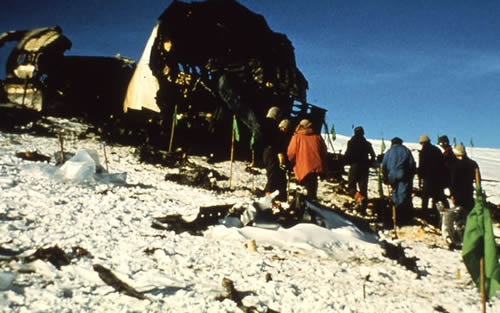
Only one section of the fuselage of the Air New Zealand DC-10 remained intact on the icy slopes of Mt Erebus. Red and green flags were used to respectively mark out the search area in a grid pattern and indicate the site of human remains.
Recovery operation begins
A break in the weather allowed the first members of the Erebus Disaster Victim Identification (DVI) team to leave McMurdo Station at 8.30 a.m. NZST* on 3 December 1979. Deteriorating weather initially hampered efforts to get the remaining team members up to the site, and a blizzard that evening prevented any work until early the following day. Bob Mitchell, the search and rescue coordinator leading the recovery operation, had flown in with the initial DVI team. He returned to McMurdo prior to the blizzard and advised the media contingent that they hoped to recover more than the 50 to 70 bodies mentioned previously.
Lone woman
Only one woman worked at the crash site, US Navy Flight-Surgeon Sandra Deegan. She had the task of examining the bodies and formally announcing that they were dead.
There was pressure to complete the recovery operation quickly because the ice runway at McMurdo would begin to thaw in mid-December, making it unusable by wheeled aircraft. This would greatly restrict the movement of aircraft and make it difficult to return bodies to New Zealand.
After the blizzard cleared the mountaineers on site broke the bridges that had formed above the crevasses and marked them with red flags (bodies and human remains were marked by green flags). The surveyors completed their grid pattern and the DVI teams began to search 30-m-square grids over the wreckage area of approximately 700 by 120 m. They tagged, photographed and bagged bodies, remains and personal belongings with reference to the grid pattern. There were five DVI teams, each made up of two policemen, a mountaineer and a photographer. McMurdo provided the photographers.
Skua gulls
Skua gulls were an ongoing source of anguish to those involved in the recovery operation. The gulls attacked bodies at the crash site, even after these were placed in body bags. They were hard to scare off and the DVI teams eventually took to covering the bodies in ice and snow while they awaited removal to McMurdo.
Mitchell had planned for the DVI teams to work in 12-hour shifts, with a break off-site before they returned. But their determination saw the men work between 15 and 20 hours a day for four days, with just short breaks on-site in their tents. The first bodies were flown back to a temporary mortuary at McMurdo by US Navy helicopters on 4 December, just hours after the start of the operation; the last followed on 10 December.
Eight of the 12 volunteers assisting US Navy Flight-Surgeon James Goodrum at the temporary mortuary at McMurdo were Americans stationed there. They volunteered in the hope of reducing the number of New Zealanders from Scott Base who would need to handle the bodies of their countrymen.
Throughout this period, the site investigation continued. It operated alongside, and where appropriate in concert with, the recovery operation. At the crash site the two teams shared food and accommodation, and assisted each other, for example, when wreckage had to be moved to uncover bodies. At McMurdo a police sergeant flown in after the main police contingent to sort through belongings recovered from the site, passed on rolls of film taken by passengers for the US Navy to develop for investigators.
* On the day of the Erebus disaster there was a one-hour time difference between New Zealand and McMurdo Station. New Zealand was observing daylight saving time, which Scott Base and McMurdo Station did not begin observing until the summer of 1992/93.
Part of: Operation Overdue
Next page: Site investigation and recovery operation conclude

Community contributions